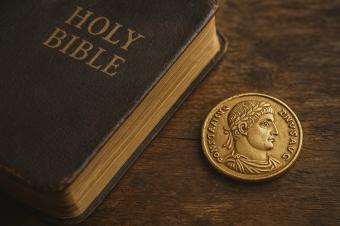
Filed: Aug 26, 2025
Opening Statement
Members of the jury, before we can weigh Christianity’s credibility, we must examine its foundation. For if the foundation is corrupt, the structure cannot stand. Christianity as an institution did not fall fully formed from heaven. It was not handed down as one unified faith. It was built, shaped, and formalized by politics – forged in the hands of emperors, councils, and ambition.
The defence may argue that this was the natural “guidance of the Spirit.” But the historical record reveals something else: a religion entangled with empire from its very beginning.
Exhibit A: Constantine – The Emperor’s Conversion
- In 312 AD, Constantine claimed to see a vision of the cross before battle, with the words “In this sign, conquer.” He won, and Christianity became the favoured religion of Rome.
- But Constantine’s “conversion” was political, not pious. He retained the title Pontifex Maximus – chief priest of the Roman gods – until his death. He was baptized only on his deathbed.
- The Council of Nicaea (325 AD), convened under his authority, was less about truth and more about unity. He needed a divided empire to have one doctrine, one God, one creed to enforce stability.
Exhibit B: The Councils and the Canon
- Councils such as Nicaea, Constantinople, and Chalcedon decided the doctrines of the church – including the very nature of Jesus. Heated debates and political maneuvering shaped the “orthodoxy.”
- Books we now call “scripture” were not self-evident; they were selected. Other gospels – Thomas, Mary, Peter – were excluded, not necessarily because they were false, but because they didn’t fit the narrative Rome endorsed.
- The Bible, the supposed “Word of God,” was curated through imperial decree.
Exhibit C: Julian the Apostate – The Empire’s Reversal
- Constantine’s nephew, Julian, raised Christian but disillusioned, later rejected the faith. History calls him “the Apostate.”
- As emperor, Julian attempted to restore pagan traditions. He saw how Christianity fractured loyalty to Rome and watched bishops exploit power.
- Ironically, Julian borrowed from Christianity’s playbook, encouraging pagan priests to provide charity and community care – proving that what made Christianity attractive was not unique revelation, but organization and politics.
Exhibit D: From Movement to Machine
- Once Christianity became the state religion, dissent became heresy. Questioning doctrine was no longer discussion; it was treason.
- Leaders who once preached humility now sat in wealth and power, backed by imperial force.
- A grassroots movement of followers became a hierarchy of bishops, emperors, and laws. What had been a faith was now an institution.
Cross-Examination
If Christianity was truly guided by divine truth, why did emperors have to decide doctrine? Why were gospels selected or discarded through political votes? Why did Julian see its leaders as power-hungry? Why did “heresy” become punishable by exile or death?
The defence cannot claim divine purity when the evidence shows political expediency.
Closing Argument
The court must conclude: Christianity was not built solely on revelation, but on Rome. Its foundation is not the unshakable rock of truth, but the shifting sands of politics.
Verdict
- The evidence proves that the Christianity we see today is not the pure faith of Jesus’ followers, but the institutional creation of emperors, councils, and compromises.
Final Word
If the foundation is political, and the structure is contradictory, then the house cannot stand. Christianity was never built solely on revelation – it was shaped by emperors, councils, and compromises.
And so, members of the jury, we now move from the foundation to the fruit. If the roots were political, what kind of harvest has grown from them? Case #7 will show that the contradictions, hypocrisies, and failures of Christianity are not anomalies. They are the inevitable result of a system built on sand.
